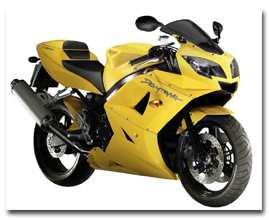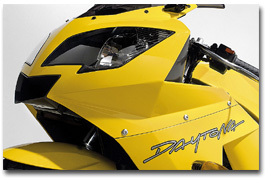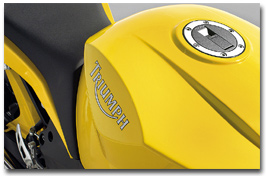
| |
||||||||||||
| |
||||||||||||
| |
||||||||||||
| For
details of how to reach over 1/4 Million readers per month - click
here |
||||||||||||
| |
||||||||||||
 |
||||||||||||
| |
||||||||||||
| |
||||||||||||
| New
Bike Guide |
||||||||||||
| The latest guide to all new UK Motorcycles and Scooters is now available on-line......click here |
||||||||||||
| Triumph Introduces New Supersports Daytona 600 | |
|
Some three years since its introduction the Triumph TT600 has evolved into one of the most complete all-round 600cc sports machines available, winning many fans for its sheer usability and almost perfect chassis. So, with the TT600 cementing its place in the model line-up for 2003 Triumph have responded to their customers' desire for a fully focused - yet very distinct and very British - supersports middleweight machine. Thus, the Daytona 600 is now reality.
Design Brief Triumph's engineers had two things in mind in the early stages of the Daytona 600's development: less weight, more power. Simple on paper - make it lighter and faster - but much harder in reality when success in the supersport class revolves around fractions saved here, linked to tiny gains there. Massive work went into the Daytona's 599cc engine - its heart and lungs. Operating efficiency in every single area was examined; friction reduced and weight saved (see Engine Tech). The target output - a super strong 112ps - was reached but not at the expense of drivability and, by utilizing Keihin twin-butterfly EFI throttle bodies and electronic 'brain,' throttle response is razor sharp and precise. Triumph have proved they can build brilliant handling motorcycles, but the Daytona 600's chassis benefited greatly from both FEA and extensive road and track evaluation at locations all over Europe. The Daytona 600's aerodynamically proven bodywork breaks new ground for Triumph and is an indication of the work that's been put in by the bike's design team. Its look, although very aggressive (as befits a supersports machine) is multifaceted, carved with subtle ellipses giving the Daytona 600 a strong, individual presence Development A supersports 600cc engine is perhaps the most finely balanced of all motorcycle power plants, packing a great deal of power into a very small space. Fuel injection has proven key in unleashing ever greater horsepower numbers from a given cubic capacity and Triumph have long been involved in pioneering this technology for motorcycle application.
The Keihin ECM utilizes a 32-bit processor. The Electronic Fuel Injection system itself is fed information from a total of seven sensors; a Manifold Air Pressure (MAP) sensor, located after the first butterfly gives a very precise gauge of the amount of fuel needed, while a barometric pressure sensor measures ambient air pressure. The wheel speed sensor monitors velocity and ensures that fueling and ignition are perfectly matched to throttle - and crankshaft - position, which have their own sensors. The air box and water temperatures are also constantly monitored. The Daytona 600's engine internals have received major attention from Triumph's engineers. Both inlet and exhaust ports have benefited from time on the flow-bench and correspondingly flow more fuel; the inlet flows 2% extra (at 9mm lift) while the exhaust flows 11% more (at 8mm lift). The combustion chamber and ports are now CNC machined, allowing much greater accuracy and consistent performance. The thermostat has been moved into the head casting for improved aesthetics while the temperature sensor is sited at the back of the head for more precise readings The lightweight exhaust system is made from 1.2mm wall thickness steel tubing and is of a 4-2-1design with headers 1-2 and 3-4 being linked, the header lengths have also been tuned to suit the new intake system, head porting and combustion chamber shape. Final gearing has been optimized in order to make best use of the engine's extra power. Peak power of 112ps arrives at 12,750rpm, with a peak torque figure of 68N/M (50.15 ft. lbs.) at 11,000rpm. Redline is set at 12,750rpm. Chassis Tech Although the TT600 has been widely acclaimed as one of the finest handling middleweight machines available, Triumph were not prepared to rest on their laurels during the Daytona 600's development. FEA was once again employed and every aspect of the new bike's chassis underwent a stringent program of analysis, design and evaluation.
Unsprung mass is highly undesirable in a supersports machine as it slows steering response, so close scrutiny was paid to the Daytona 600's suspension. The front 43mm cartridge fork benefited from a complete ground-up redesign and the use of single-rate springs. All internals - rods, cartridges and fixings - are made from aluminum saving a huge 1kg of unsprung weight, resulting in a much tauter feel and improved damping control. They are adjustable for spring preload, compression and rebound damping. The remote-reservoir rear shock has been re-valved and is also adjustable for spring preload, compression and rebound damping. Optimization of the brake pad/disc interface allowed a reduction in disc diameter of 2mm to 308mm and a savings of 170g of unsprung mass, with no reduction in braking power or sensitivity. A pair of four-piston calipers operates on the front discs and one single-piston caliper on the rear 220mm disc. Lightweight three spoke wheels are cast aluminum. Tires are Pirelli Dragon Corsas, 120/70 ZR17 front and 180/55 ZR17 rear, a super high performance sports compound tire fitted as standard, marking the Daytona 600's serious track and road intent. Conclusion The Daytona 600 is an important milestone for Triumph Motorcycles. It marks the ability of the British manufacturer to respond, not only to the fast-changing motorcycle market, but also to their customers' wishes for a machine that can perform extremely well in both racetrack and sporting road environments. And just as importantly, also proves a hugely satisfying bike to simply own. Many of Triumph's existing customers would love a hard-edged machine either as a first or second bike, but really don't want to own 'just' another 600cc sportsbike. They want cutting edge technology blended with that essential quality of Britishness that marks every Triumph motorcycle as unique. Now, in the Daytona 600, they have the machine they've been waiting for. Two paint finish options are available - Racing Yellow and Aluminum Silver, both featuring black frames and swingarms. Thanks to Triumph's commitment to producing a no-compromise sports machine there's now a new choice for any motorcyclist considering a supersports 600 machine in 2003. The Daytona 600 blends technology, performance, class, ability and beauty in one very compact and useable package. For no small reason does Triumph's new bike proudly wear its Daytona badge, and rightly so. |
|
Got something to say about this? Make your comments here! Not sure how it works or what this is all about? Fair enough - you can find out all about it here.
|
|


 The
Daytona name is the stuff of legends for Triumph Motorcycles, and
not used lightly. The subtle, discreet logo on the Daytona 600's
sleek bodywork reinforces just what this new bike is about; power,
poise and complete control. Fully aware of its lineage Triumph has
honed the Daytona 600 into an individual package that provides complete
rider involvement and satisfaction, on every level. Producing a
competitive 600cc supersports machine is no easy task and, using
knowledge learnt from the TT600 combined with major investment in
new technology and new manufacturing processes, Triumph has done
just that. Also, impressed with the need for individuality Triumph
has, in the Daytona 600, produced a machine that not only looks
very different thanks to its purposeful styling and understated
paintwork, but is also built with a great level of care and attention
to detail - harking back to the greatest traditions of British engineering
and craftsmanship.
The
Daytona name is the stuff of legends for Triumph Motorcycles, and
not used lightly. The subtle, discreet logo on the Daytona 600's
sleek bodywork reinforces just what this new bike is about; power,
poise and complete control. Fully aware of its lineage Triumph has
honed the Daytona 600 into an individual package that provides complete
rider involvement and satisfaction, on every level. Producing a
competitive 600cc supersports machine is no easy task and, using
knowledge learnt from the TT600 combined with major investment in
new technology and new manufacturing processes, Triumph has done
just that. Also, impressed with the need for individuality Triumph
has, in the Daytona 600, produced a machine that not only looks
very different thanks to its purposeful styling and understated
paintwork, but is also built with a great level of care and attention
to detail - harking back to the greatest traditions of British engineering
and craftsmanship.  A
great deal of work has gone into the Daytona 600's intake system,
maximizing efficiency and therefore power. The new intake duct at
the front of the fairing is placed in a positive pressure area,
feeding approximately 15% more air to the 8.5-liter air box. Japanese
specialist manufacturer Keihin worked very closely with Triumph
during the R&D stage of the Daytona 600's life, and have developed
the four twin butterfly 38mm diameter throttle bodies specifically
for the 599cc engine. To improve airflow and atomization the first
butterfly is controlled by the throttle while the injector itself
has been repositioned in the throttle body to inject fuel - at full
throttle - directly at the back of the first butterfly. The Keihin
Electronic Control Module controls the second butterfly, greatly
improving the all-round drivability of the power unit. All four
intake trumpet lengths have been optimized for intake pulse tuning
and new transition pieces employed for the throttle bodies. In addition,
a cam'd throttle actuator gives a 30% reduction in throttle travel.
A
great deal of work has gone into the Daytona 600's intake system,
maximizing efficiency and therefore power. The new intake duct at
the front of the fairing is placed in a positive pressure area,
feeding approximately 15% more air to the 8.5-liter air box. Japanese
specialist manufacturer Keihin worked very closely with Triumph
during the R&D stage of the Daytona 600's life, and have developed
the four twin butterfly 38mm diameter throttle bodies specifically
for the 599cc engine. To improve airflow and atomization the first
butterfly is controlled by the throttle while the injector itself
has been repositioned in the throttle body to inject fuel - at full
throttle - directly at the back of the first butterfly. The Keihin
Electronic Control Module controls the second butterfly, greatly
improving the all-round drivability of the power unit. All four
intake trumpet lengths have been optimized for intake pulse tuning
and new transition pieces employed for the throttle bodies. In addition,
a cam'd throttle actuator gives a 30% reduction in throttle travel. The
aluminum twin spar frame may look unchanged, but is in fact a brand
new design incorporating a three-cell construction, as opposed to
the four-cell of the TT600 and is lighter without sacrificing any
rigidity. Geometry-wise rake and trail are a fast-steering 24.6
degrees/89.1mm, wheelbase a compact 1390mm. The bolt-on rear sub
frame is made from 2mm box section aluminum and lighter also, but
has a very precise amount of 'flex' engineered in to absorb energy
(collected by the rider's body in the air stream) which would otherwise
be transmitted into the chassis at high speed. It supports the rakish
tail section, stepped two-piece seat and pillion pad (which can
be swapped for a color matched seat cowl) and also houses the centralized
loom and electrical system, itself much lighter. One important note
- the seat cowl is supplied with every Daytona 600, as is a color
matched rear hugger. New foot controls save weight and are also
aesthetically improved.
The
aluminum twin spar frame may look unchanged, but is in fact a brand
new design incorporating a three-cell construction, as opposed to
the four-cell of the TT600 and is lighter without sacrificing any
rigidity. Geometry-wise rake and trail are a fast-steering 24.6
degrees/89.1mm, wheelbase a compact 1390mm. The bolt-on rear sub
frame is made from 2mm box section aluminum and lighter also, but
has a very precise amount of 'flex' engineered in to absorb energy
(collected by the rider's body in the air stream) which would otherwise
be transmitted into the chassis at high speed. It supports the rakish
tail section, stepped two-piece seat and pillion pad (which can
be swapped for a color matched seat cowl) and also houses the centralized
loom and electrical system, itself much lighter. One important note
- the seat cowl is supplied with every Daytona 600, as is a color
matched rear hugger. New foot controls save weight and are also
aesthetically improved.